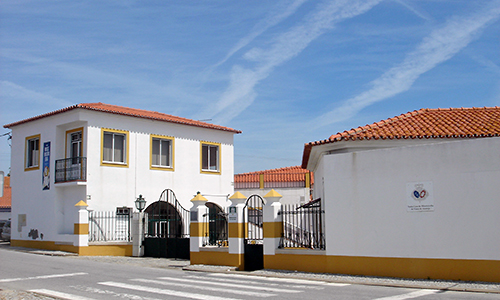 |
The Misericórdias are christian institutions of social assistance existing in Portugal since 1498, and were intended to help the disadvantaged population in a very comprehensive way: the poor, the sick, the prisoners, the orphans and the widows.
Despite the doubts that have existed about the foundation’s date of the Santa Casa da Misericórdia, we can now state that it was founded in 1516, the same year that King D. Manuel I of Portugal granted the village with Leitura Nova of the foral charter. However, the institution was only confirmed by royal charter of King D. João III, on 15th December 1525.
The loss of documentation of the Misericórdia over the centuries makes it impossible nowadays to know its ancient history, except in an occasional and sometimes indirect way. However, it is identified in a royal charter of 20th September 1608, which determined that anyone acting as Provedor (HeadMaster), clerk or member of the Bureau could only be re-elected three years after their last occupation of the post.
Being a Provedor da Misericórdia was always a position of social prestige, played by the most prominent men of the localities. In Viana’s case, Rodrigo de Vilalobos is the oldest known recorded Provedor, who carried out the position in 1543, supposedly, and concretely in 1551. There are records in the 17th century of the existence in Viana of individuals from the local elite with this same surname and the rural toponymy in the surrounding area of the village also recorded it.
Still in the 16th century - with hints to the first third of the century, according to Túlio Espanca - the church of Misericódia was built inside the rim of the castle. Possibly the space occupied by the building was ceded by the city council, that also operated inside the walled enclosure.
Also on an uncertain date of the same century, the pre-existing hospital or lodge, of medieval origin, attached to the church of Nossa Senhora da Graça (Our Lady of Grace), was integrated in the Misericórida.
Already in the 19th century, the brotherhood’s purposes continued to be the primitive ones, that is, to worship God and to exercise all works of Mercy, both corporeal and spiritual. Its special cares were to support the hospital; provide home help to the impoverished sick; organize religious festivities, wakes and other religious acts that it used to celebrate; assist the asylums of orphans and invalids of the parish; promote the appointment of delegates of the different establishments and charitable corporations of the village; to provide home help to the impoverished sick of the parish of Aguiar; subsidise primary education for the poor and conserve and increase the library, founded in 1855. Until the 19th century, the feast of Nossa Senhora da Graça was still celebrated, on 15th August, Patron saint of the former lodge. On this day alms of baked bread and meat were given to the impoverished families, already determined in the Compromisso da antiga Confraria dos Ovelheiros (Commitment of the old Confraternity of Ovelheiros) (1319).
The Misericórdia also had an apothecary's shop, or pharmacy, which, just like the hospital, was supposed to aid the impoverished sick, and operated initially inside the castle and later in the square.
There was also another institution with some local importance, whose administration was entrusted to Misericórdia. It was named Asilo Jesus Maria José (Asylum Jesus Maria José) and was created in 1908 by the will and testament of D. Inês Maria Bule, document through which she left her assets to the Santa Casa for the construction of an asylum for blind women. This was inaugurated on 8th December 1914.
Nowadays the Santa Casa still practices the purposes for which it was founded, having achieved its five hundred years of History in 2016.
REFERENCES
FARRICA, Fátima, "Inventário do Arquivo da Santa Casa da Misericórdia de Viana do Alentejo", A Cidade de Évora: Boletim de Cultura da Câmara Municipal (2ª Série), nº 8, 2009, pp. 601-635.
FARRICA, Fátima, No Espaço e no Tempo: Contributos para a História das Instituições de Viana do Alentejo (Séculos XIV-XX), Casal de Cambra, Caleidoscópio, 2015.

 Abrir Lista
Abrir Lista MUNICÍPIO DE VIANA DO ALENTEJO
MUNICÍPIO DE VIANA DO ALENTEJO